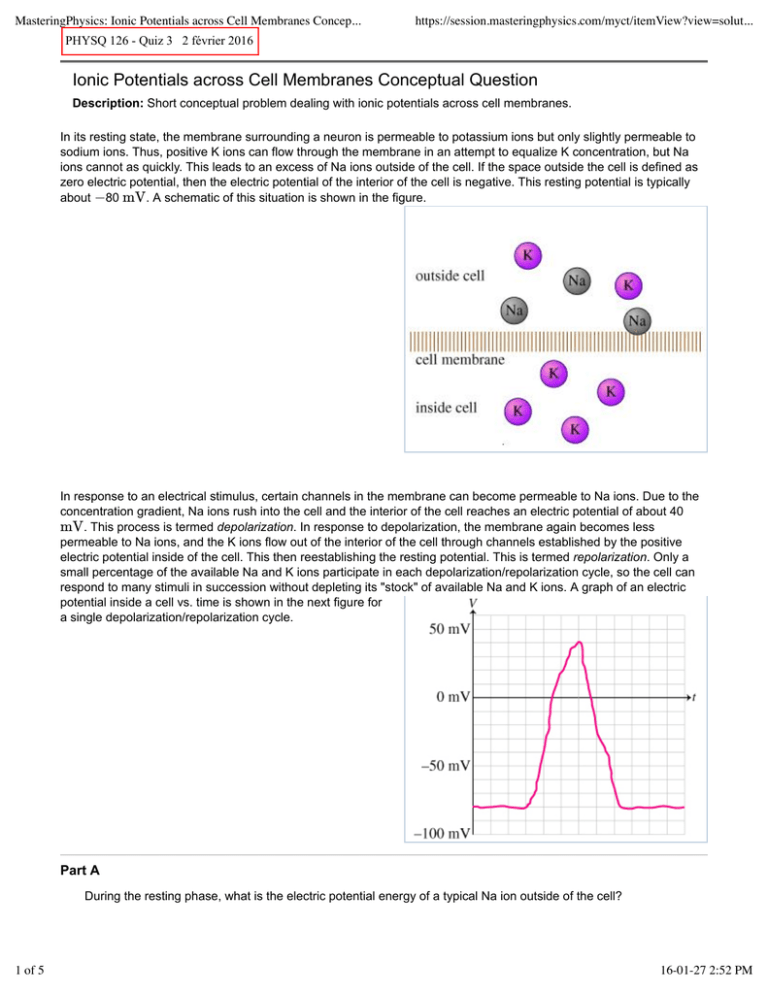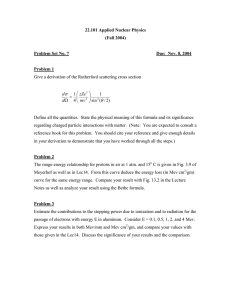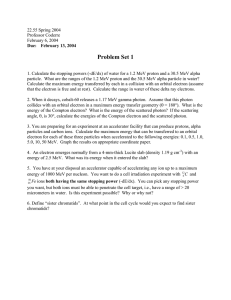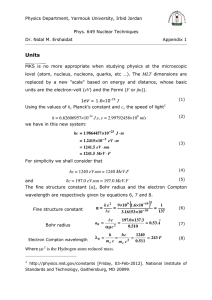Ionic Potentials Across Cell Membranes Quiz
advertisement

MasteringPhysics: Ionic Potentials across Cell Membranes Concep... https://session.masteringphysics.com/myct/itemView?view=solut... PHYSQ 126 - Quiz 3 2 février 2016 Ionic Potentials across Cell Membranes Conceptual Question Description: Short conceptual problem dealing with ionic potentials across cell membranes. In its resting state, the membrane surrounding a neuron is permeable to potassium ions but only slightly permeable to sodium ions. Thus, positive K ions can flow through the membrane in an attempt to equalize K concentration, but Na ions cannot as quickly. This leads to an excess of Na ions outside of the cell. If the space outside the cell is defined as zero electric potential, then the electric potential of the interior of the cell is negative. This resting potential is typically about −80 mV. A schematic of this situation is shown in the figure. In response to an electrical stimulus, certain channels in the membrane can become permeable to Na ions. Due to the concentration gradient, Na ions rush into the cell and the interior of the cell reaches an electric potential of about 40 mV. This process is termed depolarization. In response to depolarization, the membrane again becomes less permeable to Na ions, and the K ions flow out of the interior of the cell through channels established by the positive electric potential inside of the cell. This then reestablishing the resting potential. This is termed repolarization. Only a small percentage of the available Na and K ions participate in each depolarization/repolarization cycle, so the cell can respond to many stimuli in succession without depleting its "stock" of available Na and K ions. A graph of an electric potential inside a cell vs. time is shown in the next figure for a single depolarization/repolarization cycle. Part A During the resting phase, what is the electric potential energy of a typical Na ion outside of the cell? 1 of 5 16-01-27 2:52 PM MasteringPhysics: Ionic Potentials across Cell Membranes Concep... https://session.masteringphysics.com/myct/itemView?view=solut... Hints (1) Hint 1. The electron volt Electric potential energy is defined as U = qV . The electric charge on individual particles is always a multiple of the fundamental charge e (the charge on a single proton). Rather than substituting a numerical value for e, it is often more convenient to use the constant e as a unit. Thus, a proton located at a potential of 100 V has energy U = qV , which can be written as U = (e)(100 V) or U = 100 eV. Thus, the proton has 100 electron volts of energy. (Electron volts can be converted to the more traditional unit of energy, the joule, by multiplying by the conversion factor 1.6 × 10 −19 C/e and recalling that 1 C ⋅ V = 1 J. Thus, 100 eV = 160 × 10 −19 J.) ANSWER: −40 meV +40 meV −80 meV +80 meV 0 meV Part B During the resting phase, what is the electrical potential energy of a typical K ion inside of the cell? Hints (1) Hint 1. The electron volt Electric potential energy is defined as U = qV . The electric charge on individual particles is always a multiple of the fundamental charge e (the charge on a single proton). Rather than substituting a numerical value for e, it is often more convenient to use the constant e as a unit. Thus, a proton located at a potential of 100 V has energy U = qV , which can be written as U = (e)(100 V) 2 of 5 16-01-27 2:52 PM MasteringPhysics: Ionic Potentials across Cell Membranes Concep... https://session.masteringphysics.com/myct/itemView?view=solut... or U = 100 eV. Thus, the proton has 100 electron volts of energy. (Electron volts can be converted to the more traditional unit of energy, the joule, by multiplying by the conversion factor 1.6 × 10 −19 C/e and recalling that 1 C ⋅ V = 1 J. Thus, 100 eV = 160 × 10 −19 J.) ANSWER: −40 meV +40 meV −80 meV +80 meV 0 meV Part C During depolarization, what is the work done (by the electric field) on the first few Na ions that enter the cell? Hints (3) Hint 1. The electron volt Electric potential energy is defined as U = qV . The electric charge on individual particles is always a multiple of the fundamental charge e (the charge on a single proton). Rather than substituting a numerical value for e, it is often more convenient to use the constant e as a unit. Thus, a proton located at a potential of 100 V has energy U = qV , which can be written as U = (e)(100 V) or U = 100 eV. Thus, the proton has 100 electron volts of energy. (Electron volts can be converted to the more traditional unit of energy, the joule, by multiplying by the conversion factor 1.6 × 10 −19 C/e and recalling that 1 C ⋅ V = 1 J. Thus, 100 eV = 160 × 10 −19 J.) Hint 2. Algebraic sign of the work In general, work is defined as the product of the force applied parallel (or antiparallel) to the displacement of an object. Thus, work = Fx Δx. The work done by a force is positive if the force and the displacement are parallel; it is negative if the force and displacement are opposite in direction. 3 of 5 16-01-27 2:52 PM MasteringPhysics: Ionic Potentials across Cell Membranes Concep... https://session.masteringphysics.com/myct/itemView?view=solut... Hint 3. Magnitude of the work Work transfers energy into or out of a system. Therefore, in the absence of other energy transfers, the magnitude of the work done on an object is equal to the magnitude of the object’s change in energy. Since the primary form of energy present in this example is electric potential energy, the magnitude of the work done is equal to the change in the ion’s electric potential energy. ANSWER: −40 meV +40 meV −80 meV +80 meV −120 meV +120 meV 0 meV Part D During repolarization, what is the work done (by the electric field) on the first few K ions that exit the cell? Hints (3) Hint 1. The electron volt Electric potential energy is defined as U = qV . The electric charge on individual particles is always a multiple of the fundamental charge e (the charge on a single proton). Rather than substituting a numerical value for e, it is often more convenient to use the constant e as a unit. Thus, a proton located at a potential of 100 V has energy U = qV , which can be written as U = (e)(100 V) or U = 100 eV. Thus, the proton has 100 electron volts of energy. (Electron volts can be converted to the more traditional unit of energy, the joule, by multiplying by the conversion factor 1.6 × 10 −19 C/e and recalling that 1 C ⋅ V = 1 J. Thus, 100 eV = 160 × 10 −19 J.) Hint 2. Algebraic sign of the work In general, work is defined as the product of the force applied parallel (or antiparallel) to the displacement of an object. Thus, work = Fx Δx. The work done by a force is positive if the force and the displacement are parallel; the work done is 4 of 5 16-01-27 2:52 PM MasteringPhysics: Ionic Potentials across Cell Membranes Concep... https://session.masteringphysics.com/myct/itemView?view=solut... negative if the force and displacement are opposite in direction. Hint 3. Magnitude of the work Work transfers energy into or out of a system. Therefore, in the absence of other energy transfers, the magnitude of the work done on an object is equal to the magnitude of the object’s change in energy. Since the primary form of energy present in this example is electric potential energy, the magnitude of the work done is equal to the change in the ion’s electric potential energy. ANSWER: −40 meV +40 meV −80 meV +80 meV −120 meV +120 meV 0 meV 5 of 5 16-01-27 2:52 PM







